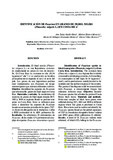Mostrar el registro sencillo del ítem
Identificación de Fusarium en granos de frijol negro (Phaseolus vulgaris L.) en Costa Rica
| dc.creator | Guido Mora, Ana Zulay | |
| dc.creator | Blanco Meneses, Mónica | |
| dc.creator | Granados Montero, María del Milagro | |
| dc.creator | Viñas Meneses, María | |
| dc.date.accessioned | 2021-07-22T19:40:31Z | |
| dc.date.available | 2021-07-22T19:40:31Z | |
| dc.date.issued | 2021-07-15 | |
| dc.identifier.citation | https://revistas.ucr.ac.cr/index.php/agrocost/article/view/47767 | |
| dc.identifier.issn | 0377-9424 | |
| dc.identifier.uri | https://hdl.handle.net/10669/84079 | |
| dc.description.abstract | Introducción. El frijol común (Phaseolus vulgaris L.) es una leguminosa consumida ampliamente en países en vías de desarrollo. En Costa Rica su consumo es alto (10,54 kg.persona-1.año-1) y su producción se localiza principalmente en regiones al sur y al norte del país. Los granos de esta leguminosa podrían estar contaminados con Fusarium, un hongo micotoxigénico que coloniza diferentes cultivos. Objetivo. Identificar las especies de Fusarium que colonizan los granos de frijol negro en Costa Rica. Materiales y métodos. Se recolectaron 49 muestras de granos de frijol negro durante 2017, 2018 y 2019 en regiones donde se produce este grano en Costa Rica. Estas se utilizaron para aislar e identificar las especies de Fusarium basado en secuencias parciales de los genes TEF1α (factor de elongación de la traducción 1-alfa) y RPB2 (subunidad de la ARN polimerasa II). Resultados. Se obtuvieron 28 aislamientos de Fusarium, de los cuales 82% pertenecen al com[1]plejo de especies Fusarium incarnatum-equiseti (FIESC). La presencia de especies de Fusarium varió según el año de recolección; en el 2018 se encontró la menor prevalencia (43%) y el 2019 la mayor (76%). El 71% de las especies de Fusarium se aislaron de muestras recolectadas en la región sur del país. F. equisetti se aisló solo de una muestra procedente de la región Atlántica, mientras que F. incarnatum, F. oxysporum y F. verticillioides se encontraron distribuidos en muestras colectadas en diferentes regiones del país. Conclusión. El presente estudio demostró la diversidad de especies de Fusarium que colonizan los granos de frijol negro en Costa Rica según la ubicación geográfica y el año de recolección de la muestra. La mayoría de las especies aisladas resultaron productoras de micotoxinas que causan efectos adversos en la salud humana. | es_ES |
| dc.description.abstract | Introduction. The common bean (Phaseolus vulgaris L.) is a legume that is widely consumed in developing countries. In Costa Rica, its consumption is still high (10.54 kg.person-1. year), and its production is mainly located in the southern and the northern regions of the country. The grains of this legume could be contaminated with Fusarium, a mycotoxigenic fungus that colonizes different crops. Objective. Identify Fusarium species that colonize the grains of Costa Rican black beans. Materials and methods. Forty-nine samples of black bean grains were collected during 2017, 2018 and 2019 in different regions where this grain is produced in Costa Rica. Those were used to isolate and identify the Fusarium species based on the partial sequences of TEF-1α (translation elongation factor 1-alpha) and RPB2 genes (RNA polymerase II subunit). Results. A total of 28 Fusarium isolates were obtained, of which 82% belong to the Fusarium incarnatum-equiseti species complex (FIESC). The presence of Fusarium species was high and varied according to the year of sample collection; thus 2018 was the year in which the lowest prevalence was found (43%) and 2019 the highest (76%). Seventy-one percent of the Fusarium species were isolated from samples collected in the Brunca region in southern Costa Rica. F. equisetti was isolated only from one sample obtained from the Huetar Atlántica region, while F. incarnatum, F. oxysporum and F. verticillioides were found distributed in samples collected in different regions of the country. Conclusion. The present study demonstrates the diversity of Fusarium species colonizing black bean grains in Costa Rica according to the geographical location and the year of collection of the samples. Most of the isolated species are well known producers of mycotoxins that cause adverse effects on human health. | es_ES |
| dc.description.sponsorship | Universidad de Costa Rica/[734-B9-038]/UCR/Costa Rica | es_ES |
| dc.language.iso | spa | es_ES |
| dc.source | Agronomía Costarricense, vol.45(2), pp.57-69 | es_ES |
| dc.subject | Micotoxinas | es_ES |
| dc.subject | Frijol común | es_ES |
| dc.subject | Phaseolus vulgaris | es_ES |
| dc.subject | Costa Rica | es_ES |
| dc.subject | Mycotoxins | es_ES |
| dc.subject | Common beans | es_ES |
| dc.title | Identificación de Fusarium en granos de frijol negro (Phaseolus vulgaris L.) en Costa Rica | es_ES |
| dc.title.alternative | Identification of Fusarium species in black bean grains (Phaseolus vulgaris L.) from Costa Rica | es_ES |
| dc.type | artículo original | |
| dc.identifier.doi | 10.15517/RAC.V45I2.47767 | |
| dc.description.procedence | UCR::Vicerrectoría de Investigación::Unidades de Investigación::Ciencias Agroalimentarias::Centro para Investigaciones en Granos y Semillas (CIGRAS) | es_ES |
| dc.description.procedence | UCR::Vicerrectoría de Investigación::Unidades de Investigación::Ciencias Agroalimentarias::Centro de Investigación en Protección de Cultivos (CIPROC) | es_ES |
| dc.identifier.codproyecto | 734-B9-038 |
Ficheros en el ítem
Este ítem aparece en la(s) siguiente(s) colección(ones)
-
Agronomía [1485]
-
Agronomía Costarricense 45(2) [1]


